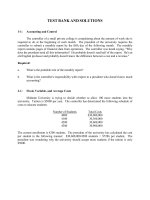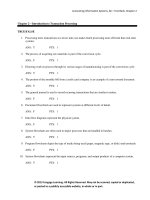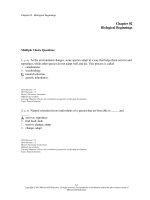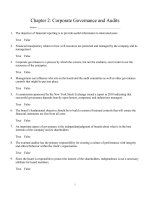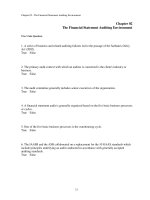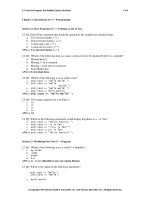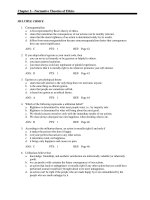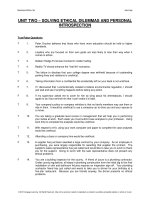Environmental law 8th edition kubasek test bank
Bạn đang xem bản rút gọn của tài liệu. Xem và tải ngay bản đầy đủ của tài liệu tại đây (361.88 KB, 12 trang )
CHAPTER 2
The issue of standing is discussed in Chapter 2 of the text. The following is the seminal
environmental case that provides the requirements for environmental groups to have standing.
SIERRA CLUB v. MORTON
United States Supreme Court
405 U.S. 727 (1972).
JUSTICE STEWART:
The Mineral King Valley is an area of great natural beauty nestled in the Sierra Nevada
Mountains in Tulare County, California, adjacent to Sequoia National Park. It has been part of the
Sequoia National Forest since 1926, and is designated as a national game refuge by special Act of
Congress. Though once the site of extensive mining activity, Mineral King is now used almost
exclusively for recreational purposes. Its relative inaccessibility and lack of development have
limited the number of visitors each year, and at the same time have preserved the valley's quality as
a quasi-wilderness area largely uncluttered by the products of civilization.
The United States Forest Service, which is entrusted with the maintenance and
administration of national forests, began in the late 1940's to give consideration to Mineral King as a
potential site for recreational development. Prodded by a rapidly increasing demand for skiing
facilities, the Forest Service published a prospectus in 1965, inviting bids from private developers for
the construction and operation of a ski resort that would also serve as a summer recreation area.
The proposal of Walt Disney Enterprises, Inc., was chosen from those of six bidders, and Disney
received a three-year permit to conduct surveys and explorations in the valley in connection with its
preparation of a complete master plan for the resort.
The final Disney plan, approved by the Forest Service in January 1969, outlines a $35 million
complex of motels, restaurants, swimming pools, parking lots, and other structures designed to
accommodate 14,000 visitors daily. This complex is to be constructed on 80 acres of the valley floor
under a 30-year use permit from the Forest Service. Other facilities, including ski lifts, ski trails, a
cog-assisted railway, and utility installations, are to be constructed on the mountain slopes and in
other parts of the valley under a revocable special-use permit. To provide access to the resort, the
State of California proposes to construct a highway 20 miles in length. A section of this road would
traverse Sequoia National Park, as would a proposed high-voltage power line needed to provide
electricity for the resort. Both the highway and the power line require the approval of the
Department of the Interior, which is entrusted with the preservation and maintenance of the national
parks
Representatives of the Sierra Club, who favor maintaining Mineral King largely in its present
state, followed the progress of recreational planning for the valley with close attention and increasing
dismay. They unsuccessfully sought a public hearing on the proposed development in 1965, and in
subsequent correspondence with officials of the Forest Service and the Department of the Interior,
they expressed the Club's objections to Disney's plan as a whole and to particular features included
in it. In June 1969 the Club filed the present suit in the United States District Court for the Northern
District of California, seeking a declaratory judgment that various aspects of the proposed
development contravene federal laws and regulations governing the preservation of national parks,
forests, and game refuges, and also seeking preliminary and permanent injunctions restraining the
federal officials involved from granting their approval or issuing permits in connection with the
©2014 Pearson Education, Inc. Publishing as Prentice Hall
10
Mineral King project. The petitioner Sierra Club sued as a membership corporation with "a special
interest in the conservation and the sound maintenance of the national parks, game refuges and
forests of the country," and invoked the judicial-review provisions of the Administrative Procedure
Act, 5 U.S.C. '701 et seq.
After two days of hearings, the District Court granted the requested preliminary injunction. It
rejected the respondents' challenge to the Sierra Club's standing to sue, and determined that the
hearing had raised questions "concerning possible excess of statutory authority, sufficiently
substantial and serious to justify a preliminary injunction. . . ." The respondents appealed, and the
Court of Appeals for the Ninth Circuit reversed . . . With respect to the petitioner's standing, the court
noted that there was "no allegation in the complaint that members of the Sierra Club would be
affected by the actions of [the respondents] other than the fact that the actions are personally
displeasing or distasteful to them," id, at 33, and concluded:
"We do not believe such club concern without a showing of more direct interest can constitute
standing in the legal sense sufficient to challenge the exercise of responsibilities on behalf of all
the citizens by two cabinet level officials of the government acting under Congressional and
Constitutional authority," . . .
Alternatively, the Court of Appeals held that the Sierra Club had not made an adequate showing of
irreparable injury and likelihood of success on the merits to justify issuance of a preliminary
injunction. The court thus vacated the injunction. The Sierra Club filed a petition for a writ of
certiorari which we granted, . . ., to review the questions of federal law presented.
The first question presented is whether the Sierra Club has alleged facts that entitle it to
obtain judicial review of the challenged action. Whether a party has a sufficient stake in an
otherwise justiciable controversy to obtain judicial resolution of that controversy is what has
traditionally been referred to as the question of standing to sue. Where the party does not rely on
any specific statute authorizing invocation of the judicial process, the question of standing depends
upon whether the party has alleged such a "personal stake in the outcome of the controversy." . . .
as to ensure that "the dispute sought to be adjudicated will be presented in an adversary context
and in a form historically viewed as capable of judicial resolution." . . . the inquiry as to standing must
begin with a determination of whether the statute in question authorizes review at the behest of the
plaintiff.
The Sierra Club relies upon '10 of the Administrative Procedure Act (APA), 5 U.S.C. Section
702, which provides:
"A person suffering legal wrong because of agency action, of adversely affected or
aggrieved by agency action within the meaning of a relevant statute, is entitled to
judicial review thereof."
Early decisions under this statute interpreted the language as adopting the various formulations of
"legal interest" and "legal wrong" then prevailing as constitutional requirements of standing. But, in
Association of Data Processing Service Organizations, Inc. v. Camp, . . . decided the same day, we
held more broadly that persons had standing to obtain judicial review of federal agency action under
'10 of the APA where they had alleged that the challenged action had caused them "injury in fact,"
and where the alleged injury was to an interest "arguably within the zone of interests to be protected
or regulated" by the statutes that the agencies were claimed to have violated.
...
The injury alleged by the Sierra Club will be incurred entirely by reason of the change in the
uses to which Mineral King will be put, and the attendant change in the aesthetics and ecology of
the area. Thus, in referring to the road to be built through Sequoia National Park, the complaint
alleged that the development "would destroy or otherwise adversely affect the scenery, natural and
historic objects and wildlife of the park and would impair the enjoyment of the park for future
©2014 Pearson Education, Inc. Publishing as Prentice Hall
11
generations." We do not question that this type of harm may amount to an "injury in fact" sufficient
to lay the basis for standing under Section 10 of the APA. Aesthetic and environmental well-being,
are important ingredients of the quality of life in our society, and the fact that particular
environmental interests are shared by the many rather than the few does not make them less
deserving of legal protection through the judicial process. But the "injury in fact" test requires more
than an injury to a cognizable interest. It requires that the party seeking review be himself among
the injured.
The impact of the proposed changes in the environment of Mineral King will not fall
indiscriminately upon every citizen. The alleged injury will be felt directly only by those who use
Mineral King and Sequoia National Park, and for whom the aesthetic and recreational values of the
area will be lessened by the highway and ski resort. The Sierra Club failed to allege that it or its
members would be affected in any of their activities or pastimes by the Disney development.
Nowhere in the pleadings or affidavits did the Club state that its members use Mineral King for any
purpose, much less that they use it in any way that would be significantly affected by the proposed
actions of the respondents.
The Club apparently regarded any allegations of individualized injury as superfluous, on the
theory that this was a "public" action involving questions as to the use of natural resources, and that
the Club's longstanding concern with and expertise in such matters were sufficient to give it standing
as a "representative of the public." This theory reflects a misunderstanding of our cases involving
so-called "public actions" in the area of administrative law.
Taken together, Saunders and Scripps-Howard thus established a dual proposition: the fact
of economic injury is what gives a person standing to seek judicial review under the statute, but
once review is properly invoked, that person may argue the public interest in support of his claim
that the agency has failed to comply with its statutory mandate. It was in the latter sense that the
"standing" of the appellant in Scripps-Howard existed only as a "representative of the public
interest." It is in a similar sense that we have used the phrase "private attorney general" to describe
the function performed by persons upon whom Congress has conferred the right to seek judicial
review of agency action. . . .
The trend of cases arising under the APA and other statutes authorizing judicial review of
federal agency action has been toward recognizing that injuries other than economic harm are
sufficient to bring a person within the meaning of the statutory language, and toward discarding the
notion that an injury that is widely shared is ipso facto not an injury sufficient to provide the basis for
judicial review. We noted this development with approval in Data Processing, . . ., in saying that the
interest alleged to have been injured "may reflect ‘aesthetic, conservational, and recreational' as well
as economic values." But broadening the categories of injury that may be alleged in support of
standing is a different matter from abandoning the requirement that the party seeking review must
himself have suffered an injury.
Some courts have indicated a willingness to take this latter step by conferring standing upon
organizations that have demonstrated "an organizational interest in the problem" of environmental or
consumer protection. . . .But a mere "interest in a problem," no matter how longstanding the interest
and no matter how qualified the organization is in evaluating the problem, is not sufficient by itself to
render the organization "adversely affected" or "aggrieved" within the meaning of the APA. The
Sierra Club is a large and long-established organization, with a historic commitment to the cause of
protecting our Nation's natural heritage from man's depredations. But if a "special interest" in this
subject were enough to entitle the Sierra Club to commence this litigation, there would appear to be
no objective basis upon which to disallow a suit by any other bona fide "special interest" organization
©2014 Pearson Education, Inc. Publishing as Prentice Hall
12
however small or short-lived. And if any group with a bona fide "special interest" could initiate such
litigation, it is difficult to perceive why any individual citizen with the same bona fide special interest
would not also be entitled to do so.
The requirement that a party seeking review must allege facts showing that he is himself
adversely affected does not insulate executive action from judicial review, nor does it prevent any
public interests from being protected through the judicial process. It does serve as at least a rough
attempt to put the decision as to whether review will be sought in the hands of those who have a
direct stake in the outcome. That goal would be undermined were we to construe the APA to
authorize judicial review at the behest of organizations or individuals who seek to do no more than
vindicate their own value preferences through the judicial process. The principle that the Sierra Club
would have us establish in this case would do just that.
...
Inanimate objects are sometimes parties in litigation. A ship has a legal personality, a fiction
found useful for maritime purposes. The corporation sole--a creature of ecclesiastical law--is an
acceptable adversary and large fortunes ride on its cases. The ordinary corporation is a "person" for
purposes of the adjudicatory processes, whether it represents proprietary, spiritual, aesthetic, or
charitable causes.
So it should be as respects valleys, alpine meadows, rivers, lakes, estuaries, beaches,
ridges, groves of trees, swampland, or even air that feels the destructive pressures of modern
technology and modern life. The river, for example, is the living symbol of all the life it sustains or
nourishes--fish, aquatic insects, water ouzels, otter, fisher, deer, elk, bear, and all other animals,
including man, who are dependent on it or who enjoy it for its sight, its sound, or its life. The river as
plaintiff speaks for the ecological unit of life that is part of it. Those people who have a meaningful
relation to that body of water--whether it be a fisherman, a canoeist, a zoologist, or a logger--must
be able to speak for the values which the river represents and which are threatened with destruction.
I do not know Mineral King. I have never seen it nor traveled it, though I have seen articles
describing its proposed "development" notably Hano, Protectionists vs. recreationists-- . . .The
Sierra Club in its complaint alleges that "[o]ne of the principal purposes of the Sierra Club is to
protect and conserve the national resources of the Sierra Nevada Mountains." The District Court
held that this uncontested allegation made the Sierra Club "sufficiently aggrieved" to have "standing"
to sue on behalf of Mineral King.
Mineral King is doubtless like other wonders of the Sierra Nevada such as Tuolumne
Meadows and the John Muir Trail. Those who hike it, fish it, or visit it merely to sit in solitude and
wonderment are legitimate spokesmen for it, whether they may be few or many. Those who have
that intimate relation with the inanimate object about to be injured, polluted, or otherwise despoiled
are its legitimate spokesmen.
The Solicitor General, whose views on this subject are in the Appendix to this opinion, takes
a wholly different approach. He considers the problem in terms of "government by the Judiciary."
With all respect, the problem is to make certain that the inanimate objects, which are the very core
of America's beauty, have spokesmen before they are destroyed. It is, of course, true that most of
them are under the control of a federal or State agency. The standards given those agencies are
usually expressed in terms of the "public interest." Yet "public interest" has so many differing
shades of meaning as to be quite meaningless on the environmental front...
Yet the pressures on agencies for favorable action one way or the other are enormous. The
suggestion that Congress can stop action which is undesirable is true in theory; yet even Congress
©2014 Pearson Education, Inc. Publishing as Prentice Hall
13
is too remote to give meaningful direction and its machinery is too ponderous to use very often. The
federal agencies of which I speak are not venal or corrupt. But they are notoriously under the
control of powerful interests who manipulate them through advisory committees, or friendly working
relations, or who have that natural affinity with the agency which in time develops between the
regulator and the regulated...
...
The Forest Service--one of the federal agencies behind the scheme to despoil Mineral King-has been notorious for its alignment with lumber companies, although its mandate from Congress
directs it to consider the various aspects of multiple use in its supervision of the national forests.
The voice of the inanimate object, therefore, should not be stilled. That does not mean that
the judiciary takes over the managerial functions from the federal agency. It merely means that
before these priceless bits of Americana (such as a valley, an alpine meadow, a river, or a lake) are
forever lost or are so transformed as to be reduced to the eventual rubble of our urban environment,
the voice of the existing beneficiaries of these environmental wonders should be heard.
Perhaps they will not win. Perhaps the bulldozers of "progress" will plow under all the
aesthetic wonders of this beautiful land. That is not the present question. The sole question is, who
has standing to be heard?
Those who hike the Appalachian Trail into Sunfish Point, New Jersey, and camp or sleep
there, or run the Allagash in Maine, or climb the Guadalupes in West Texas, or who canoe and
portage the Quetico Superior in Minnesota, certainly should have standing to defend those natural
wonders before courts or agencies, though they live 3,000 miles away. Those who merely are
caught up in environmental news or propaganda and flock to defend these waters or areas may be
treated differently. That is why these environmental issues should be tendered by the inanimate
object itself. Then there will be assurances that all of the forms of life which it represents will stand
before the court--the pileated woodpecker as well as the coyote and bear, the lemmings as well as
the trout in the streams. Those inarticulate members of the ecological group cannot speak. But
those people who have so frequented the place as to know its values and wonders will be able to
speak for the entire ecological community.
Ecology reflects the land ethic; and Aldo Leopold wrote in “A Sand County Almanac” . . .
"The land ethic simply enlarges the boundaries of the community to include soils, waters, plants, and
animals, or collectively: the land."
That, as I see it, is the issue of "standing" in the present case and controversy.
___________________________________________
The Supreme Court considers the elements of standing for a particular environmental statute in the
following case.
STEEL COMPANY v. CITIZENS FOR A BETTER ENVIRONMENT
United States Supreme Court
523 U.S. 118 (1998).
JUSTICE SCALIA:
©2014 Pearson Education, Inc. Publishing as Prentice Hall
14
Respondent, an association of individuals interested in environmental protection, sued
petitioner, a small manufacturing company in Chicago, for past violations of EPCRA. EPCRA
establishes a framework of State, regional and local agencies designed to inform the public about
the presence of hazardous and toxic chemicals, and to provide for emergency response in the event
of health-threatening release. Central to its operation are reporting requirements compelling users of
specified toxic and hazardous chemicals to file annual emergency and hazardous chemical
inventory forms and toxic chemical release forms, which contain, inter alia, the name and location of
the facility, the name and quantity of the chemical on hand, and, in the case of toxic chemicals, the
waste-disposal method employed and the annual quantity released into each environmental
medium.
For purposes of this case, . . . the crucial enforcement mechanism is the citizen-suit
provision, which authorizes civil penalties and injunctive relief. This provides that “any person may
commence a civil action on his own behalf against [a]n owner or operator of a facility for failure,
among other things, to [c]omplete and submit an inventory form under section 11022(a) of this title
[and] section 11023(a) of this title. “ As a prerequisite to bringing such a suit, the plaintiff must, 60
days prior to filing his complaint, give notice to the Administrator of the EPA, the State in which the
alleged violation occurs, and the alleged violator. The citizen suit may not go forward if the
Administrator “has commenced and is diligently pursuing an administrative order or civil action to
enforce the requirement concerned or to impose a civil penalty.”
In 1995 respondent sent a notice to petitioner, the Administrator, and the relevant Illinois
authorities, alleging, accurately, as it turns out, that petitioner had failed since 1988, the first year of
EPCRA’s filing deadlines, to complete and to submit the requisite hazardous-chemical inventory and
toxic-chemical release forms under ''11022 and 11023. Upon receiving the notice, petitioner filed all
of the overdue forms with the relevant agencies. The EPA chose not to bring an action against
petitioner, and when the 60-day waiting period expired, respondent filed suit in Federal District
Court. Petitioner promptly filed a motion to dismiss under Federal Rule of Civil Procedure 12(b)(1)
and (6), contending that, because its filings were up to date when the complaint was filed, the court
had no jurisdiction to entertain a suit for a present violation; and that, because EPCRA does not
allow suit for a purely historical violation, respondent’s allegation of untimeliness in filing was not a
claim upon which relief could be granted.
The District Court agreed with petitioner on both points. The Court of Appeals reversed,
concluding that citizens may seek penalties against EPCRA violators who file after the statutory
deadline and after receiving notice. We granted certiorari.
We granted certiorari in this case to resolve a conflict between the interpretation of EPCRA
adopted by the Seventh Circuit and the interpretation previously adopted by the Sixth Circuit in
Atlantic States Legal Foundation, Inc. v. United Musical Instruments, U.S. A., Inc., 61 F.3d 473
(1995)Ba case relied on by the District Court, and acknowledged by the Seventh Circuit to be
factually indistinguishable, Petitioner, however, both in its petition for certiorari and in its briefs on the
merits, has raised the issue of respondent's standing to maintain the suit, and hence this Court’s
jurisdiction to entertain it. Though there is some dispute on this point, see Part III, infra, this would
normally be considered a threshold question that must be resolved in respondent’s favor before
proceeding to the merits. Justice Stevens’s opinion concurring in the judgment, however, claims that
the question whether '11046(a) permits this cause of action is also jurisdictional, and so has
equivalent claim to being resolved first.
...
[W]e arrive at the threshold jurisdictional question: whether respondent, the plaintiff below,
©2014 Pearson Education, Inc. Publishing as Prentice Hall
15
has standing to sue. Article III, Section 2 of the Constitution extends the judicial power of the United
States only to “Cases” and “Controversies.” We have always taken this to mean cases and
controversies of the sort traditionally amenable to and resolved by the judicial process. Such a
meaning is fairly implied by the text, since otherwise the purported restriction upon the judicial power
would scarcely be a restriction at all. Every criminal investigation conducted by the Executive is a
“case,” and every policy issue resolved by congressional legislation involves a “controversy. These
are not, however, the sort of cases and controversies that Article III, §2, refers to, since the
Constitution’s central mechanism of separation of powers depends largely upon common
understanding of what activities are appropriate to legislatures, to executives, and to courts.
Standing to sue is part of the common understanding of what it takes to make a justiciable case.
The “irreducible constitutional minimum of standing” contains three requirements. First and
foremost, there must be alleged (and ultimately proven) an “injury in fact,” a harm suffered by the
plaintiff that is “concrete” and “actual or imminent,” not “conjectural or hypothetical. “ Second, there
must be causation, a fairly traceable connection between the plaintiff’s injury and the complained-of
conduct of the defendant. And third, there must be redressability, a likelihood that the requested
relief will redress the alleged injury. This triad of injury in fact, causation, and redressability
comprises the core of Article III’s case-or-controversy requirement, and the party invoking federal
jurisdiction bears the burden of establishing its existence.
We turn now to the particulars of respondent’s complaint to see how it measures up to Article
III’s requirements. This case is on appeal from a Rule 12(b) motion to dismiss on the pleadings, so
we must presume that the general allegations in the complaint encompass the specific facts
necessary to support those allegations. The complaint contains claims “on behalf of both
[respondent] itself and its members.” It describes respondent as an organization that seeks, uses,
and acquires data reported under EPCRA. It says that respondent “reports to its members and the
public about storage and releases of toxic chemicals into the environment, advocates changes in
environmental regulations and statutes, prepares reports for its members and the public, seeks the
reduction of toxic chemicals and further seeks to promote the effective enforcement of
environmental laws.” The complaint asserts that respondent’s “right to know about [toxic chemical]
releases and its interests in protecting and improving the environment and the health of its members
have been, are being, and will be adversely affected by [petitioner’s] actions in failing to provide
timely and required information under EPCRA.” The complaint also alleges that respondent’s
members, who live in or frequent the area near petitioner’s facility, use the EPCRA-reported
information “to learn about toxic chemical releases, the use of hazardous substances in their
communities, to plan emergency preparedness in the event of accidents, and to attempt to reduce
the toxic chemicals in areas in which they live, work and visit.” The members’ ‘safety, health,
recreational, economic, aesthetic and environmental interests’ in the information, it is claimed, “have
been, are being, and will be adversely affected by [petitioner’s] actions in failing to file timely and
required reports under EPCRA.”
As appears from the above, respondent asserts petitioner’s failure to provide EPCRA
information in a timely fashion, and the lingering effects of that failure, as the injury in fact to itself
and its members. We have not had occasion to decide whether being deprived of information that is
supposed to be disclosed under EPCRA, or at least being deprived of it when one has a particular
plan for its use, is a concrete injury in fact that satisfies Article III. And we need not reach that
question in the present case because, assuming injury in fact, the complaint fails the third test of
standing, redressability.
The complaint asks for (1) a declaratory judgment that petitioner violated EPCRA; (2)
authorization to inspect periodically petitioner’s facility and records (with costs borne by petitioner);
©2014 Pearson Education, Inc. Publishing as Prentice Hall
16
(3) an order requiring petitioner to provide respondent copies of all compliance reports submitted to
the EPA; (4) an order requiring petitioner to pay civil penalties of $25,000 per day for each violation
of ''11022 and 11023; (5) an award of all respondent’s costs, in connection with the investigation
and prosecution of this matter, including reasonable attorney and expert witness fees, as authorized
by Section 326(f) of [EPCRA]”; and (6) any such further relief as the court deems appropriate. App.
11. None of the specific items of relief sought, and none that we can envision as appropriate under
the general request, would serve to reimburse respondent for losses caused by the late reporting, or
to eliminate any effects of that late reporting upon respondent.
The first item, the request for a declaratory judgment that petitioner violated EPCRA, can be
disposed of summarily. There being no controversy over whether petitioner failed to file reports, or
over whether such a failure constitutes a violation, the declaratory judgment is not only worthless to
respondent, it is seemingly worthless to all the world.
Item (4), the civil penalties authorized by the statute, see '11045(c), might be viewed as a
sort of compensation or redress to respondent if they were payable to respondent. But they are not.
These penalties are the only damages authorized by EPCRA and are payable to the United States
Treasury. In requesting them, therefore, respondent seeks not remediation of its own injury, but
reimbursement for the costs it incurred as a result of the late filing – but vindication of the rule of law
– the “undifferentiated public interest” in faithful execution of EPCRA. This does not suffice. . . . By
the mere bringing of his suit, every plaintiff demonstrates his belief that a favorable judgment will
make him happier. But although a suitor may derive great comfort and joy from the fact that the
United States Treasury is not cheated, that a wrongdoer gets his just desserts, or that the nation’s
laws are faithfully enforced, that psychic satisfaction is not an acceptable Article III remedy because
it does not redress a cognizable Article III injury. Relief that does not remedy the injury suffered
cannot bootstrap a plaintiff into federal court; that is the very essence of the redressability
requirement.
Item (5), the “investigation and prosecution” costs “as authorized by Section 326(f),” would
assuredly benefit respondent as opposed to the citizenry at large. Obviously, however, a plaintiff
cannot achieve standing to litigate a substantive issue by bringing suit for the cost of bringing suit.
The litigation must give the plaintiff some other benefit besides reimbursement of costs that are a
byproduct of the litigation itself. An “interest in attorney’s fees is insufficient to create an Article III
case or controversy where none exists on the merits of the underlying claim.” Respondent asserts
that the “investigation costs” it seeks were incurred prior to the litigation, in digging up the emissions
and storage information that petitioner should have filed, and that respondent needed for its own
purposes. The recovery of such expenses unrelated to litigation would assuredly support Article III
standing, but the problem is that '326(f), which is the entitlement to monetary relief that the complaint
invokes, covers only the “costs of litigation.” 8 '11046(f). Respondent finds itself, in other words,
impaled upon the horns of a dilemma: for the expenses to be reimbursable under the statute, they
must be costs of litigation; but reimbursement of the costs of litigation cannot alone support
standing.
The remaining relief respondent seeks (item (2), giving respondent authority to inspect
petitioner’s facility and records, and item (3), compelling petitioner to provide respondent copies of
EPA compliance reports) is injunctive in nature. It cannot conceivably remedy any past wrong but is
aimed at deterring petitioner from violating EPCRA in the future. The latter objective can of course
be “remedial” for Article III purposes, when threatened injury is one of the gravamens of the
complaint. If respondent had alleged a continuing violation or the imminence of a future violation, the
injunctive relief requested would remedy that alleged harm. But there is no such allegation here--and
on the facts of the case, there seems no basis for it. Nothing supports the requested injunctive relief
©2014 Pearson Education, Inc. Publishing as Prentice Hall
17
except respondent’s generalized interest in deterrence, which is insufficient for purposes of Article
III.
The United States, as amicus curiae, argues that the injunctive relief does constitute
remediation because “there is a presumption of [future] injury when the defendant has voluntarily
ceased its illegal activity in response to litigation,” even if that occurs before a complaint is filed. This
makes a sword out of a shield. The “presumption” the Government refers to has been applied to
refute the assertion of mootness by a defendant who, when sued in a complaint that alleges present
or threatened injury, ceases the complained-of activity. It is an immense and unacceptable stretch to
call the presumption into service as a substitute for the allegation of present or threatened injury
upon which initial standing must be based. To accept the Government’s view would be to overrule
our clear precedent requiring that the allegations of future injury be particular and concrete. “Past
exposure to illegal conduct does not in itself show a present case or controversy regarding injunctive
relief if unaccompanied by any continuing, present adverse effects.” Because respondent alleges
only past infractions of EPCRA, and not a continuing violation or the likelihood of a future violation,
injunctive relief will not redress its injury.
Having found that none of the relief sought by respondent would likely remedy its alleged
injury in fact, we must conclude that respondent lacks standing to maintain this suit, and that we and
the lower courts lack jurisdiction to entertain it. However desirable prompt resolution of the merits
EPCRA question may be, it is not as important as observing the constitutional limits set upon courts
in our system of separated powers. EPCRA will have to await another day.
The judgment is vacated and the case remanded with instructions to direct that the complaint be
dismissed.
___________________________________________
QUESTIONS
True or False
1.
Arbitration and mediation are two non-adversarial alternatives to litigation.
2.
If a person receives a summons and complaint, but fails to appear for hearings or
trial, the court may still have jurisdiction over that person and could render a decision
affecting his or her rights.
3.
The least adversarial alternative to litigation is arbitration.
4.
Trial courts are courts of original jurisdiction in most cases.
5.
The attorney-client privilege is designed to encourage the client to tell the truth to his
attorney.
6.
One of the common criticisms of the adversary system is that it unfairly benefits the
wealthier party.
7.
Cases must initially be heard in courts of appellate jurisdiction.
8.
Subject matter jurisdiction determines whether a case is heard in state or federal
©2014 Pearson Education, Inc. Publishing as Prentice Hall
18
court.
9.
10.
A right of removal allows the defendant to move a case from the state court system
in which it's filed to a federal court system.
Federal judges are appointed, while most state judges are elected.
Multiple Choice
1.
Which of the following is not considered one of the threshold issues that must be
met before one can bring a lawsuit?
a.
b.
c.
d.
2.
A case challenging a statute as violating a person's rights under the U. S.
Constitution
a.
b.
c.
d.
3.
subject matter jurisdiction.
jurisdiction over the person.
either a or b.
both a and b.
Standing
a.
b.
c.
d.
5.
must be heard in a State court.
must be heard in a federal court.
may be heard in either State or federal court.
must be heard in the U. S. Court of Claims.
To render a binding decision in a case, a court must have
a.
b.
c.
d.
4.
standing.
ripeness.
case or controversy.
none of the above (all must be present).
requires proof of an injury in fact and of an interest that is directly affected by
the challenged action.
is usually not difficult to establish when challenging the action of an agency
under an environmental statute.
both a and b.
none of the above.
The federal district court and the court of common pleas have concurrent jurisdiction
over
a.
b.
c.
d.
cases involving the interpretation of the Constitution.
most cases requiring the interpretation of a federal statute.
both a and b.
none of the above.
©2014 Pearson Education, Inc. Publishing as Prentice Hall
19
6.
Federal judges
a.
b.
c.
d.
7.
The purpose of serving the summons and complaint is to
a.
b.
c.
d.
8.
c.
d.
is supposed to ensure that jurors are not biased.
allows for removal of potential jurors through both peremptory and for cause
challenges.
both a and b.
none of the above.
If a defendant wants to sue a plaintiff, then the defendant should also file a(n) _____
with the answer.
a.
b.
c.
d.
10.
give the defendant notice of the pending action against her.
give the court jurisdiction over the defendant.
give the court subject matter jurisdiction over the case.
both a and b.
The voir dire process
a.
b.
9.
are appointed by the president with the advice and consent of the Senate.
are allowed to serve for life, assuming "good behavior."
are elected.
both a and b.
counterclaim.
information.
either a or b.
none of the above. He must wait until the plaintiff's case has been decided.
Grand juries
a.
b.
c.
d.
are used in only criminal cases.
are used in only civil cases.
are used to decide the facts in a case.
both a and c.
Answers to the critical thinking questions regarding “Does a Turtle Have More
Rights Than a Human?”
1. Identify the conclusions and reasons of the article.
The author concludes that the Supreme Court ruling was correct: property owners should have
©2014 Pearson Education, Inc. Publishing as Prentice Hall
20
the right to bring suits against overzealous regulation. Why should property owners have the right to
bring suits? She offers two reasons for her conclusion. First, property owners are economically
harmed by over-regulation. If they are harmed, they should have the right to bring a suit. Second, the
author suggests that if a turtle or inanimate object has the right to bring a suit, any human should
also be able to bring a suit because a human’s rights are more important than an animal’s or
inanimate object’s right.
2. Identify the ethical norm guiding the author’s thinking.
The author seems to value security, in the sense that she wants property rights protected above
almost anything else. Furthermore, if a person is harmed, she believes they should have the right to
bring a suit in response to that harm. She wants to be sure that property rights will be protected.
Thus, she argues that property owners should be allowed to bring suit against overzealous
regulation.
3. Which ethical norm seems to conflict with the author’s preferred ethical norm?
Justice seems to conflict with security because the author wants to give preference to humans
over animals. Perhaps animals and humans should have equal protection rights under the law. If
justice is defined as equal protection under the law, the animals are not receiving justice. If the
reader valued justice over security, he or she would probably disagree with the author’s reasoning.
©2014 Pearson Education, Inc. Publishing as Prentice Hall
21
